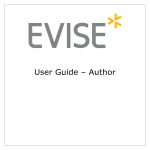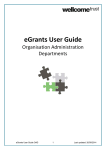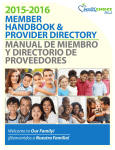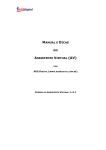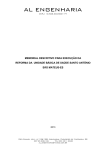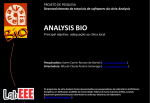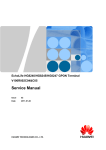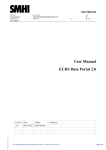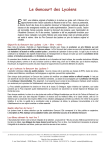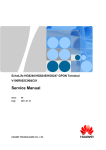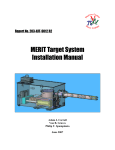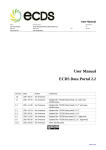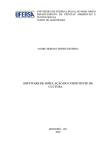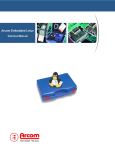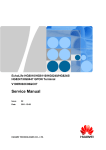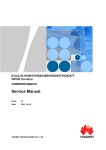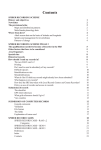Download (IAD) Web Service - Earth and Planetary Remote Sensing Laboratory
Transcript
Interagency Data Web Service Manual -‐ Version 2.0 May 2014 Interagency Data (IAD) Web Service 1. About the IAD 1.1. General Requirements 1.2. Understanding Key Components 1.3. Getting Started 2. Using the IAD 2.1. Authentication 2.2. POST (Submit/Update) and GET (Retrieve) 2.3. Response and Notifications from IAD 3. IAD’s Metadata Fields 3.1. Required Metadata 3.2. Optional Metadata 4. Appendices 4.1. Sample XML records 4.2. Sample Landing Pages 1.0 About the IAD OSTI’s Interagency Data (IAD) Web Service allows U.S. federal agencies to obtain persistent identifiers known as Digital Object Identifiers (DOIs) for datasets and ensures that the DOIs are properly registered with DataCite. The Office of Scientific and Technical Information (OSTI) became a member and an allocating agency for DataCite in 2011. OSTI can assign DOIs to the Department of Energy through its Data ID Service and to other U.S. agencies through a similar web service, the IAD. IAD provides an easy-‐to-‐use mechanism to submit, edit, or retrieve registration records. Users can manipulate records by performing HTTP operations on the web service URL and providing XML metadata to create/update records (POST) or to retrieve records for review (GET). Submitting agencies agree to ensure data persistence, which includes storing and managing their registered datasets such that access and usability are provided indefinitely. The URL associated with each DOI should point to an HTML “landing page” that provides additional needed information, such as a list of contents if multiple data files are included in the registered dataset. Note that datasets are not uploaded or stored at OSTI. Page 1 of 13 1.1 General Requirements These general requirements have been established for data registration. The submitter must: • Provide, at minimum, the required metadata to enable basic, bibliographic citation • Have authority (though not necessarily ownership) to make public the assets for which they wish to assign the DOIs. • Guarantee the persistence of registered data o By ensuring that data will be stored and managed such that access and usability are provided indefinitely. o By maintaining and updating as necessary all URLs associated with the DOI • Establish and maintain appropriate landing pages for registered DOIs 1.2 Understanding Key Components Defining Datasets: Content and Granularity Determining how DOIs should be applied to your data, i.e. at what level of granularity, is an important step in planning data registration. Some datasets are similar to collections in that they include multiple data files. The DOI can be assigned at the collection level, with the included data files listed individually on the dataset’s landing page. Another option is to break the collection down in some logical way by topic, by geographic location, by time period, etc. and assign a DOI to each of these smaller “sets” of multiple files. On the other extreme, a dataset may also be as simple as a spreadsheet. Datasets are not always numeric in nature. A computer model and sets of “canned” input could be a dataset, while each of the simulations or output files could be assigned their own DOIs. A collection of photographs or a graphic of a workflow can be registered as a dataset. Interactive resources or audiovisual items may be assigned DOIs. Data “studies” can be registered also; these may include a variety of materials associated together as a “package.” Subject expertise and knowledge of how your audiences normally look for your data will help you determine the appropriate content and boundaries of the datasets that you intend to register. OSTI can provide advice and share examples of best practices, but granularity decisions are ultimately the responsibility of the people who know the data best, i.e. the creators, the analysts, or the data center experts at your submitting organization. IAD’s Digital Object Identifier (DOI) Each time a new submitting entity becomes an IAD “data client,” OSTI requests from DataCite a numeric prefix which will belong only to that one, specific entity. A data client may be an entire agency or a center or office within the agency, an observatory or other facility, or even one specific project. DataCite and IAD ensure that no two data clients will ever have the same DOI prefix. A DOI consists of the number 10, followed by a period, followed by the data client’s prefix, a forward slash, and a numeric suffix. The suffix assigned by IAD is the OSTI ID, a unique identifier that every record processing through any of OSTI’s systems, including IAD, must receive. Page 2 of 13 What makes the DOI not only a unique identifier, but a “persistent” identifier is the commitment behind it. Data clients commit to update the URLs for their DOIs whenever a posted landing page and its associated dataset must be moved to a new online address. The DOI will never change, but the URL, which is invisibly “bonded” to a DOI in the DataCite Registry, can change. Changing the URL in DataCite’s Registry is accomplished via IAD through a simple POST operation to update the affected record. DataCite recommends that DOIs in a citation or database be displayed as live links, i.e. with http://dx.doi.org/ preceding the beginning of the actual DOI numbers or characters. This is not a requirement, but it is a “best practice.” Example: http://dx.doi.org/10.5439/1021460 The Landing Page A “landing page” or introductory page is recommended by DataCite for all registered data and actually required in two cases (See next paragraph). The DOI points to the landing page, which in turn, links out to the dataset itself. The landing page, which must always be publicly accessible, provides context for the dataset. The landing page may contain one or more of the following: • Information on how a full, formal citation of the data should appear, • Access information, including a notice of temporary restriction, if necessary, • Links to software or toolkits needed to open, download, or analyze the data, • A listing of the individual data files that may be included in the registered dataset (with links to them), • Update and version information, • Contact information. DataCite notes two cases when a landing page is mandatory rather than recommended. A landing page is mandatory for any data that cannot be viewed using standard desktop software. A landing page is also mandatory when the data has restricted access. Because DOIs are not deleted from the DataCite Registry, a landing page can also serve as a “tombstone page” when a dataset must become unavailable. The tombstone page should tell a user who has followed the original DOI to that point what has happened to the data, why, and provide a contact for further questions. 1.3 Getting Started Access to the IAD requires the submitter to have an active, approved account. To request your account, send email to [email protected]. Once an account is established, the account holder then submits records to a test environment and does a coordinated review of the results with OSTI before POSTing the first “live” file in production mode. The test URL for the web service is https://www.osti.gov/iadtest/dataapi. The URL for production use of the Interagency Data Web Service is provided when the TEST activities have been completed. Page 3 of 13 2.0 Using the IAD 2.1 Authentication Each POST or GET request requires authentication through an approved web service account. The IAD Web Service supports HTTP Basic authentication over Secure Socket Layer (SSL). With this method, the client server connects to the IAD server using HTTPS URLs (https://www.osti.gov/iadtest/dataapi for testing). The POST and GET verb commands will pass along the standard Authentication HTTP header (base64 encoding). 2.2 POST (Submit/Update) and GET (Retrieve) If authentication is successful, the input body of the request is read as an XML document, parsed, and submitted appropriately. The HTML status code for successful connection and an XML response, which includes certain metadata fields, are returned at the end of processing each request. The POST request is used to submit metadata for a new record that will receive a new DOI. It is also used to edit or update an existing record that has previously been submitted. When requesting an existing record in order to update it, the OSTI ID must be included in the XML record. The updated record will then overwrite the specified record. Note: The DOI previously obtained for this dataset must also be included in the XML record being resubmitted for edit/update. If it is not included, the system will attempt to re-‐register and obtain a new DOI. This situation requires significant effort to correct. Metadata can be retrieved for any record previously submitted by your organization by using a GET request and supplying the osti_id argument on the command line. Authentication is required and is handled in the same fashion as a Create/Modify command. The requested OSTI ID returns that specific XML record. 2.3 Response and Notifications from IAD The IAD server makes an immediate response when the client-‐side server sends a POST or a GET request. The primary goal of the response is two-‐fold: let the client server “know” if it connected successfully and provide a status message about the record that was POSTed or retrieved. The status says SUCCESS if the record correctly transmitted and the metadata loaded into the processing system. The status says FAILURE if the record was unable to load into the processing system for any reason. The FAILURE response includes a status message indicating the error or problem that kept the record from loading. Errors leading to a FAILURE response occur when a required metadata field is missing, when a site URL cannot be validated as correct by the automated validation process, when a value is too long for the field it must load into, etc. An example of each response type appears below. Note that the successful record returns its newly assigned OSTI ID and its newly assigned DOI. The response for the failed record has neither, since OSTI IDs and DOIs cannot be given to records that never actually make it into the processing system. Page 4 of 13 POST SUCCESSFUL – SAMPLE RESPONSE FROM IAD SERVER <?xml version=”1.0” encoding=”UTF-‐8”?> <records> <record> <osti_id>1035366</osti_id> <product_nos>none</product_nos> <title>ARM Climate Modeling Best Estimate Lamont, OK (ARMBE-‐CLDRAD SGPC1)</title> <contract_nos>AC05-‐00OR22725</contract_nos> <doi>http://dx.doi.org/10.5439/1035366</doi> <status>SUCCESS</status> <status_message></status_message> </record> </records> POST FAILURE – SAMPLE RESPONSE FROM IAD SERVER <?xml version=”1.0” encoding=”UTF-‐8”?> <records> <record> <osti_id>0</osti_id> <product_nos>none</product_nos> <title>ARM Climate Modeling Best Estimate Lamont, OK (ARMBE-‐CLDRAD SGPC1)</title> <contract_nos>AC05-‐00OR22725</contract_nos> <doi></doi> <status>FAILURE</status> <status_message>Data too long, maximum number of characters for dataset type is 2</status_message> </record> </records> IAD also sends an automated email to those at the submitting site that wish to be on the distribution list. The email reports the same information as the server response message but can reach a wider audience, if necessary. It is the submitting organization’s responsibility to review the returned messages, correct any errors, and resubmit the failed records. 3.0 IAD’s Metadata Fields The following two tables list the required and optional metadata fields, their XML tags, and the related business rules governing submission to the Interagency Data (IAD) Web Service. Records without required fields will fail to load into IAD and will not receive DOIs. Only a few metadata and/or administrative fields are required. The other fields available for use are optional, though several, such as the Abstract/Description, are highly encouraged. Third party indexing services often integrate with the DataCite Registry (where the IAD sends your metadata) to reflect the DOIs and associated Page 5 of 13 information in their own products. The more metadata these services can pick up from DataCite, the more retrievable your datasets will be. The OSTI ID and the previously assigned DOI is a required field for all POST requests where the intent is to edit or update records. The GET request must also include the OSTI ID (though including the DOI is not necessary for GET) and will allow retrieval of a record previously submitted by your site. Please note that there are two ways to submit Creator/PI/Author names. These two methods cannot be combined in one record. A record must use either the single tag <creators> and combine all names into one character string OR if any of the names have an accompanying ORCID, a record must use the <creatorsblock> which includes several tags for each creator name. 3.1 Required/Mandatory Tags and Values Field XM L Tag Definitions, Com m ents/Business Rules OSTI ID+ <osti_id> DOI+ (if one has already been assigned) <doi> The OSTI ID is required in all requests intended to edit or update records. When POSTing new records to OSTI, no <osti_id> tag is needed in the XML. The IAD automatically assigns an OSTI ID to each record successfully submitted; you will receive it in the XML response returned automatically to your site. A previously assigned DOI is required in all POST requests intended to edit or update records. When POSTing new records to OSTI, no <osti_id> tag or <doi> tag is needed in the XML. The IAD assigns both to each record successfully submitted; you will receive it in the XML response returned to your site. Dataset Title <title/> Full title of the dataset. Include version numbers and specific date ranges when applicable. Creator(s) / Principle Investigator(s)/ Authors <creators/> <creatorsblock> <creators_detail> <first_name></first_name> <middle_name></middle_name> <last_name></last_name> <affiliation></affiliation> <private_email></private_email> <orcid_id></orcid_id> </creators_detail> </creatorsblock> <publisher/> You may use this field if you are NOT submitting ORCID IDs with any of the creator/PI (or author) names in the record. Format for names is last name, first name, middle initial. Multiple creator names, separated with a semi-‐colon and a space are allowed. Creator(s) / Principle Investigator(s) Originating Research Org or Submitting Org Page 6 of 13 Use the <creatorsblock> tags if you ARE including ORCID number with any of the creators/PIs (authors) in the submitted record. When the submitted record has the <creatorsblock> tags, ALL creator/PI/author names MUST be broken out into this block format (even if only one of the names has an accompanying ORCID). The entity that originated, holds, issues, or produces the dataset/information product. Publication Date <publication_date/> URL of landing page/dataset <site_url/> Contact Name and Position <contact_name/> Contact Organization <contact_org/> Contact Email <contact_email/> Contact Phone <contact_phone/> The date when the dataset or information product was published or issued. Required format is mm/dd/yyyy (example: 04/17/2011) The unique URL where the dataset’s landing page is posted for access. The landing page must contain the direct link to the dataset itself. The name and position of the main point of contact for the dataset being registered. The organization of the main point of contact for the dataset being registered. The email address of the main point of contact for the dataset being registered. The phone number of the main point of contact for the dataset being registered. + Only required when a POST is intended to update or modify a previously submitted record OR when a GET command is intended to retrieve a previously submitted record for review. 3.2 Optional Metadata Fields Field XM L Tag Definitions, Com m ents/Business Rules Specific Product Type <product_type_specific> Dataset Product Number(s) <product_nos/> Description/ Abstract <description/> IAD automatically defaults to “Dataset” for the overall (generic or high level) product type. However, submitters are encouraged to use the <product_type_specific> tag to indicate the main or most important part of the dataset’s actual content. This is a free text field. Example 1: Numeric Data Example 2: Computer model and sample input files Example 3: Photograph Collection A unique identifying number that has been assigned to the dataset by originating, hosting, or submitting organization. Multiple IDs may be in this field. Separate the multiples with a semi-‐colon and a space. A clear, concise summary of the content of the dataset, as well as specialized parameters that describe the data. Specialized parameters may include a date range during which information was taken (such as May, 01 2002 -‐ December 31, 2002), geographic information (such as a specific state, region, country, latitude and longitude, etc.), information such as temperature ranges, etc. The abstract length should be no more than 5,000 characters. Note: The ampersand (&) character is not XML compliant. All ampersands should be sent as & Terms that could be important for subject indexing or particularly helpful for search and retrieval. Keywords Keywords, Subject <keywords> Terms or Topics, etc. Page 7 of 13 Related Resource <related_resource/> Contributor Organizations <contributor_organizations/> Sponsoring Organizations <sponsor_org/> Contract or Grant Number(s) <contract_nos/> Other Identifying Numbers Dataset File Extension <other_identifying_nos/> Availability <availability/> <file_extension/> may be terms or phrases. Separate multiples with a semi-‐colon and a slash. Brief citation information (title, author, identifier) for key publication(s) or report(s) that the dataset being registered directly supports. A DOI for the related resource can also go here, though it will not be processed as a live link. The names of any organizations that have significantly contributed to the gathering, formatting, analysis, etc. of the dataset. These are organizations that would not otherwise be credited because they will not be listed in the Publisher field, or in the Sponsoring Organization field. Names of Collaborations should also be given here. The name(s) of the organization(s) that funded the work which produced the dataset or information products. Separate multiple organizations with a semi-‐colon and a space. The contract number or grant/award number under which the work that produced the dataset or information product was funded. If the dataset is the result of a joint effort between two or more funding entities, additional contract numbers may be entered. When more than one is entered, the first one given is considered the primary funding contract. Separate multiples with a semi-‐colon and a slash. Any other identifying number(s) The file extension of the dataset. Knowing the type of file posted will be important to users as they decide whether they can easily open the dataset. Some common file extensions are .txt, .csv, .ps, etc. The name of any office or organization that can offer additional help in obtaining or utilizing the dataset. 4.0 Appendices Appendix 4.1: Sample XML records Sample of a new XML record to be POSTED: Record uses the single field, character string entry for the <creators> field because none of the creators show accompanying ORCIDs. <?xml version=”1.0” encoding=”UTF-‐8”?> <records> <record> Page 8 of 13 <title>LBA Regional Global Historical Climatology Network, V.1, 1832-‐1990</title> <creators>Vose, R.S.; Schmoyer, R.L.; Steurer, P.M.; Peterson, T.C.; Hein, R.; Karl, T.R.; Eischeid, J.K.</creators> <creators_emails></creators_emails> <publisher>ORNL Distributed Active Archive Center (DAAC) for Biogeochemical Dynamics, National Aeronautics and Space Administration</publisher> <publication_date>12/31/2002</publication_date> <site_url> http://daac.ornl.gov/cgi-‐bin/dsviewer.pl?ds_id=702</site_url> <product_type_specific>Numeric Data<product_type_specific> <product_nos></product_nos> <description> This dataset consists of a subset of the Global Historical Climatology Network (GHCN) Version 1 database for the study area of the Large Scale Biosphere-‐Atmosphere Experiment in Amazonia (LBA) in South America (i.e., longitude 85 to 30 degrees W, latitude 25 degrees S to 10 degrees N). There are three files available, one each for precipitation, temperature, and pressure data. Within this subset the oldest data date from 1832 and the most recent from 1990. All data taken at Latitude: 10.00N To 25.00S, Longitude: 30.00W to 85.00W. More information about LBA and links to other LBA project sites can be found at http://www.daac.ornl.gov/LBA/misc_amazon.html. </description> <keywords>Rainforest; FIFE; BOREAS; Remote-‐Sensing Techniques; Selective Logging; Carbon Storage; Nutrient Dynamics; Trace Gas Fluxes</keywords> <related_resource></related_resource> <contributor_organizations></contributor_organizations> <sponsor_org>National Aeronautics and Space Administration (NASA), U.S.; Centro de Previsao de Tempo e Estudos Climaticos, Brazil; Instituto Nacional De Pesquisas Espaciais, Brazil); Instituto Nactional de Pesquisas da Amazonia, Brazil</sponsor_org> <contract_nos></contract_nos> <other_identifying_nos></other_identifying_nos> <file_extension>.dat</file_extension> <availability>ORNL DAAC</availability> <contact_name>J. Smith</contact_name> <contact_org>ORNL DAAC</contact_org> <contact_email>[email protected]</contact_email> <contact_phone>865-‐497-‐3155</contact_phone> </record> </records> Sample of a new XML record to be POSTED: Record names one creator/PI (who happens to have an ORCID ID) and uses the ORCID-‐related fields. <?xml version=”1.0” encoding=”UTF-‐8”?> <records> <record> <title>2010 Survey, Endangered Sea Turtles, Florida Atlantic Coast </title> <creatorsblock> <creators_detail> <first_name>Jesse</first_name <middle_name>D.</middle_name. <last_name>Johnson</last_name> Page 9 of 13 <affiliation>NOAA</affiliation> <private_email></private_email> <orcid_id>0000-‐0002-‐8924-‐3894<orcid_id> </creators_detail> </creatorsblock> <publisher>Southeast Fisheries Science Center, National Marine Fisheries Service, NOAA</publisher> <publication_date>06/14/2012</publication_date> <site_url> http://www.sefsc.noaa.gov/species/turtles/</site_url> <product_type_specific>Survey Data<product_type_specific> <product_nos>SFSC232012</product_nos> <description>This survey reports the results of the 2012 effort to log existing tag numbers of endangered sea turtles and to also assign new IDs to untagged sea turtles. This survey is conducted annual along Florida’s Atlantic Coast between Jacksonville and the southernmost boundary of Dade County.</description> <keywords>Protected Species</keywords> <related_resource>Working the Sea Turtle Survey. Jesse D. Johnson and Arnold Imagined. Resource Watch, Volume 34, Issue 10, 2013.</related_resource> <contributor_organizations>Florida Atlantic University</contributor_organizations> <sponsor_org>National Oceanic and Atmospheric Administration (NOAA)</sponsor_org> <contract_nos></contract_nos> <other_identifying_nos></other_identifying_nos> <file_extension>.txt</file_extension> <availability></availability> <contact_name>Sheila Jones</contact_name> <contact_org>NOAA SFSC</contact_org> <contact_email>[email protected]</contact_email> <contact_phone>893-‐987-‐5436</contact_phone> </record> </records> Sample of a new XML record to be POSTED: Record names three creators/PIs. Only one has an ORCID; the other two do not. However, if any creator/PI in a record has an ORCID, the ORCID-‐ related fields (<creatorsblock>, etc) must be used in that record. <?xml version=”1.0” encoding=”UTF-‐8”?> <records> <record> <title>Repetitive Flu-‐like Episodes: Data Comparisons from Ten Western States</title> <creatorsblock> <creators_detail> <first_name>Amy</first_name <middle_name>J.</middle_name. <last_name>Askins</last_name> <affiliation>CDC</affiliation> <private_email>[email protected]</private_email> <orcid_id><orcid_id> </creators_detail> <creators_detail> Page 10 of 13 <first_name>Horace</first_name <middle_name></middle_name. <last_name>Bart</last_name> <affiliation>Los Angeles Health Department</affiliation> <private_email></private_email> <orcid_id>0000-‐0001-‐8123-‐0763<orcid_id> </creators_detail> <creators_detail> <first_name>Marcus</first_name <middle_name>D.</middle_name. <last_name>Welby</last_name> <affiliation>University of Oregon</affiliation> <private_email></private_email> <orcid_id><orcid_id> </creators_detail> </creatorsblock> <publisher>Centers for Disease Control and Prevention (CDC)</publisher> <publication_date>07/14/2010</publication_date> <site_url>http://www.cdc.gov/ncbddd/flu/western/</site_url> <product_type_specific>Data Studies<product_type_specific> <product_nos></product_nos> <description></description> <keywords>Virus; Flu Anomalies</keywords> <related_resource></related_resource> <contributor_organizations>Lawrence Livermore National Laboratory (LLNL)</contributor_organizations> <sponsor_org>Centers for Disease Control and Prevention (CDC); National Institutes of Health (NIH)</sponsor_org> <contract_nos>CDC-‐NIH-‐40376-‐2010</contract_nos> <other_identifying_nos></other_identifying_nos> <file_extension>.xls</file_extension> <availability></availability> <contact_name>Shane Harmon</contact_name> <contact_org>CDC</contact_org> <contact_email>[email protected]</contact_email> <contact_phone>204-‐874-‐2189</contact_phone> </record> </records> Page 11 of 13 Appendix 4.2: Landing Page Examples from CXIDB and ARM Page 12 of 13 Page 13 of 13













